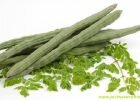
Moringa sometimes described as the “miracle tree,” “drumstick tree,” or “horseradish tree,” has small, rounded leaves that are packed with an incredible amount of nutrition: protein, calcium, beta- carotene, vitamin C, potassium… you name it, moringa’s got it. No wonder it’s been used medicinally (and as a food source) for at least 4,000 years.
Its leaves have been used as part of traditional medicine for centuries, and the Ayurvedic system of medicine associates it with the cure or prevention of about 300 diseases. From a digestive standpoint, moringa is high in fiber that, “works like a mop in your intestines… to clean up any of that extra grunge left over from a greasy diet.” Also noteworthy are its isothiocyanates, which have anti-bacterial properties that may help to rid your body of H. pylori, a bacteria implicated in gastritis, ulcers, and gastric cancer.
Moringa seeds have even been found to work better for water purification than many of the conventional synthetic materials in use today.
Moringa leaves are loaded with vitamins, minerals, essential amino acids, and more.
One hundred grams of dry moringa leaf contains:
- 9 times the protein of yogurt
- 10 times the vitamin A of carrots
- 15 times the potassium of bananas
- 17 times the calcium of milk
- 12 times the vitamin C of oranges
- 25 times the iron of spinach
Moringa leaves are rich in antioxidants, including vitamin C, beta-carotene, quercetin, and chlorogenic acid. The latter, chlorogenic acid, has been shown to slow cells’ absorption of sugar and animal studies have found it to lower blood sugar levels.
One study found women who took seven grams of moringa leaf powder daily for three months reduced their fasting blood sugar levels by 13.5 percent.
Studies show that moringa leaves possess anti-tumor and anti-cancer activities, due in part to a compound called niaziminin. Preliminary experimentation also shows activity against the Epstein-Barr virus. Compounds in the leaf appear to help regulate thyroid function, especially in cases of hyper -active thyroid. Further research points to anti-viral activity in cases of Herpes simplex 1.
In the traditional medicinal systems of many cultures, plants with long uses and benefits remain to be discovered. Moringa oleifera, unknown in the market just ten years ago, is surging into greater popularity due to its multiple health benefits and nutritious value as a food.
Moringa is a valuable plant medicine and deserves a place in the home pharmacy.
Moringa is now extensively cultivated throughout Asia, Africa, the Caribbean and Central America, but the largest Moringa crop in the world is produced by India – where it grows natively. It’s fascinating to note that may be one reason why the death rate from pancreatic cancer in India is a stunning 84% lower than in the United States!
NOTE: As always, this article is not medical advice nor a substitute for consultation with a medical professional.
If you want to learn how to grow your own medicinal herbs and discover how to use them to heal your body and mind, take a look at the Everyday Roots Book. It’s a Book that’s created to help you replace the toxic products and medications in your home with healthier, all-natural alternatives.
It contains 215+ effective home remedies and covers everything you will need to protect your family and save money every month.




